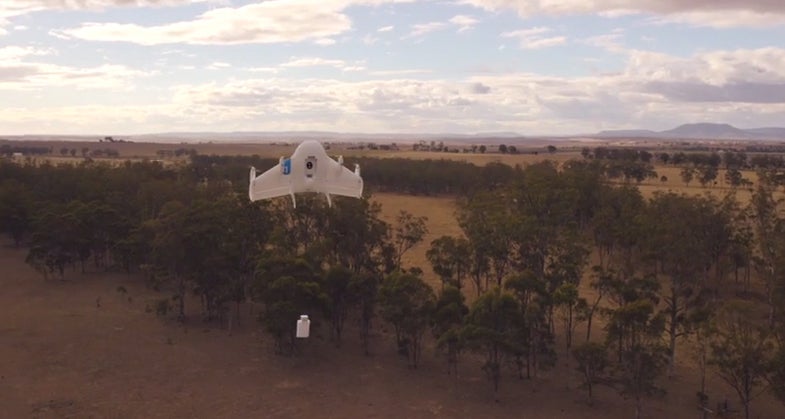Google Already Testing Delivery Robots In Australia
First, the outback. Next: your backyard.

In rural Australia, a drone delivers dog treats to a farmer. The robot is a proof of concept, part of Project Wing by Google X. The program is designed to show that delivery drones are possible, and it seems to be doing just that. Next for Google: figuring out the path from proven prototype to everyday utility.
The drone is a tail-sitter, taking off vertically with its body perpendicular to the ground. At rest, it looks like a tiny spaceship from a 1930s comic book. It’s a type of Vertical Takeoff or Landing (VTOL) rarely done with humans on board, because that transition, from vertical to horizontal and back again, is difficult for onboard human pilots to manage. For the drone it works fine, and the design lets the wing fly fast like a plane. It also means the drone can hover, and that’s where the delivery mechanism of Project Wing shines:
A working delivery mechanism is the first step for the service. With the prototype in place, the next challenge is creating an infrastructure for drones so that they can travel safely through skies without hitting other vehicles. Google’s driverless car program is an obvious touchstone for this project, but it’s a limited one. Cars on roads travel in close proximity and only move in two dimensions. Aircraft operate in vast, empty skies, and do so on three axes. Training a car to sense and avoid other cars is simpler than doing the same for an aircraft. Still, Google’s development and prior experience with cars is a strong sign that this work will continue and ultimately yield fruit. Michael Toscano, CEO of the Association for Unmanned Vehicle Systems International, said that
It’s worth noting that Google tested this technology in Australia first. While the FAA clearly wants drones to sense and avoid other aircraft, its been slow to implement changes and create a regulatory framework that lets innovation like this happen stateside. If the drone industry wants to change the world, it’ll need an FAA that lets it deliver. Watch the drone in action below, and read more about Project Wing at The Atlantic.

